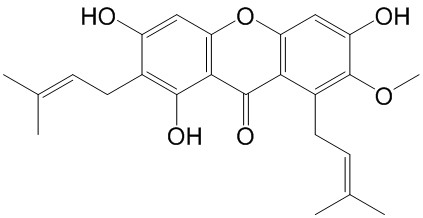Home
Products
alpha-Mangostin



| Product Name | alpha-Mangostin |
| Price: | Inquiry |
| Catalog No.: | CN05815 |
| CAS No.: | 6147-11-1 |
| Molecular Formula: | C24H26O6 |
| Molecular Weight: | 410.5 g/mol |
| Purity: | >=98% |
| Type of Compound: | Xanthones |
| Physical Desc.: | Yellow powder |
| Source: | The fruits of Garcinia mangostana. |
| Solvent: | Chloroform, Dichloromethane, Ethyl Acetate, DMSO, Acetone, etc. |
| SMILES: | COc1c(O)cc2c(c1CC=C(C)C)c(=O)c1c(o2)cc(c(c1O)CC=C(C)C)O |
| Contact us | |
|---|---|
| First Name: | |
| Last Name: | |
| E-mail: | |
| Question: | |
| Description | Alpha-mangostin is a dietary xanthone with broad biological activities, such as antioxidant, anti-allergic, antiviral, antibacterial, anti-inflammatory and anticancer effects. It is an inhibitor of mutant IDH1 (IDH1-R132H) with a Ki of 2.85 μM. |
| Target | IC50: 2.85 μM (IDH1-R132H)[1] |
| In Vitro | Alpha-mangostin exhibits a selective inhibitory effect on IDH1-R132H, but not on IDH1. Alpha-mangostin competitively inhibits the binding of alpha-mangostin (α-KG) to IDH1-R132H. The structure–relationship study reveals that alpha-mangostin exhibits the strongest core inhibitor structure. Alpha-mangostin selectively promotes demethylation of 5-methylcytosine (5mC) and histone H3 trimethylated lysine residues in IDH1 (+/R132H) MCF10A cells[1]. Cell proliferation significantly decreases in a dose-dependent manner in the cells treated with alpha-mangostin. Alpha-mangostin also increases the levels of Bax (pro-apoptotic), cleaved caspase-3, cleaved caspase-9 and cleaved-poly(ADP-ribose) polymerase (PARP)[2]. Alpha-mangostin significantly inhibits light-induced degeneration of photoreceptors and 200 μM H2O2-induced apoptosis of RPE cells. 200 μM H2O2-induced generation of reactive oxygen species (ROS) and light-induced generation of malondialdehyde (MDA) are suppressed by alpha-mangostin[3]. |
| In Vivo | Alpha-mangostin reduces risk of liver fibrosis through the decrease in p53 expression as compared to the TAA_DMSO treatment. The serum levels of the liver enzymes AST and ALT after treatment with α-mangostin decrease as compared to DMSO alone[4]. |
| Cell Assay | IDH1+/+ and IDH1 MCF10A cells are grown in DMEM/F-12 media, supplemented with 5% horse serum, 20 ng/mL EGF, 0.5 μg/mL hydrocortisone, 10 μg/mL insulin. IDH1+/+ and IDH1 MCF10A cells are seeded in 6 well plates. After an exposure to 5 μM alpha-mangostin. cells are collected after indicated times and the viable cell number is calculated, using hemacytometer counting[1]. |
| Animal Admin | Rats: Male Wistar rats are divided into 3 groups and treated with intraperitoneal injections of TAA (200 mg/kg). One subgroup is left untreated whereas the other two are treated either with 100 mg/kg alpha-mangostin or vehicle alone (80% DMSO, 20% water), which are administered intraperitoneally 3 times per weekfor a total of4 weeks. The incidence offibrotic nodules on the liver and the serum levels of the liver enzymes aspartate transaminase (AST) and alanine transaminase (ALT) are measured[4]. |
| Density | 1.3±0.1 g/cm3 |
| Boiling Point | 640.1±55.0 °C at 760 mmHg |
| Flash Point | 220.3±25.0 °C |
| Exact Mass | 410.172943 |
| PSA | 100.13000 |
| LogP | 5.45 |
| Vapour Pressure | 0.0±2.0 mmHg at 25°C |
| Storage condition | 2-8°C |